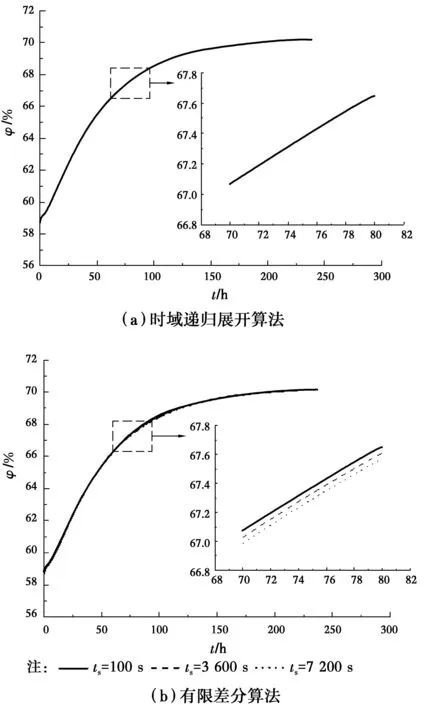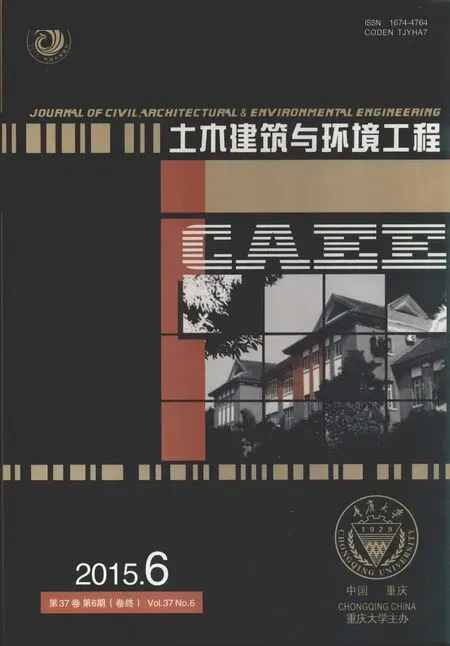墙体内热湿耦合过程的时域递归展开算法
墙体内热湿耦合过程的时域递归展开算法

张景欣1,郭兴国1,陈友明2,陈国杰2,3
(1. 南昌大学 建筑工程学院,南昌 330031;2. 湖南大学 土木工程学院,长沙 410082;
3. 南华大学 城市建设学院,湖南 衡阳 421001)
摘要:利用时域递归展开算法对墙体内热湿耦合传递方程进行求解。以木板为例,应用该算法进行了热湿耦合传递的分析计算,在时间域和空间域上分别运用递归展开法和控制容积法进行离散,从而得到递归形式的线性方程组,运用MATLAB软件对这一过程进行求解。计算结果与有限差分算法、解析解计算结果以及实验数据吻合良好,表明该算法能够用于求解多孔介质热湿耦合传递模型。时间步长的改变对计算结果影响较小,可通过增加时间步长方法来减少工作量。
关键词:热湿耦合传递;时域分析;时间步长
Received:2015-07-18
Foundation item: National Natural Science Foundation of China (No. 51208247, 51408294, 51078127)
Author brief:Zhang Jingxin (1990-), main research interests:building energy consumption evaluation and simulation research, (E-mail) zhangjingxin_90@163.com.
在热湿气候地区,墙体的热湿迁移对围护结构的热工性能、建筑能耗和室内环境有着十分重要的影响[1-2]。因此,研究多孔材料的热湿迁移,预测材料内部温度和湿度的分布对改善围护结构的热工性能、抑制霉菌生长、提高围护结构的耐久性具有重大意义。而建立多孔材料热湿传递模型和采用高精度的算法是研究这些问题的基本前提。
许多学者采用的热湿耦合传递模型为Luikov模型[3]。该模型可以就建筑材料和建筑结构在真实外界条件下长期变化的特性做出模拟,奠定了液态水和水蒸气同时传递模型的理论基础。一些学者对Luikov方程进行了改进和完善[4-5],得到了一维瞬态热湿耦合传递方程的解析解。对于热湿耦合传递模型的数值解法,被广泛采用的主要是有限元法和有限差分法[6-8]。Kerget等[9]采用基于边界元法的数值模型对多孔介质非线性热湿耦合传递进行了模拟,此方法减少了问题的维数,但应用范围以存在相应微分算子的基本解为前提。郭兴国等[10]运用有限容积法对多层墙体热湿耦合模型进行了求解,此类方法时间步长选择受到一定的限制。Mendes等[11]运用有限差分方法对方程进行离散,并用MTDMA(Multitridiagonal-Matrix Algorithm)对离散后的方程进行求解。李凤志等[12]利用时域递归展开算法求解了织物热湿耦合方程,该方法的主要优点是时间步长的选取几乎不受限制。
笔者建立了多孔介质一维热湿传递控制方程,在时域上采用了递归展开算法,有效克服了有限差分法对时间步长的限制问题,在空间域上采用有限容积法对方程进行离散,并且用MATLAB编程进行求解。计算结果与有限差分方法的计算结果以及文献[5]中的解析解、实验数据进行比较,证明了此解法的正确性。研究结果表明,该方法能够用于墙体热湿耦合迁移方程的求解。
1热湿耦合模型的建立
1.1 控制微分方程
在多孔建筑墙体内热湿耦合过程中,根据质量和能量守恒方程可得多孔建筑墙体的内热湿耦合微分方程[13]
(1)
(2)
式中:T为温度,K;t为时间,s;Cp为材料的比热,J/(kg·K);Cm为材料的比湿,kg/(kg·°M);k为导热系数,W/(m·K);Dm为材料的质扩散系数,kg/(m·s·°M);ρ为干材料的密度,kg/m3;ε为相变因子,m3/m3;γ为吸附或解吸附热,kJ/kg;δ为热梯度系数,°M/K;hlv为蒸发潜热,J/kg;m为湿度势,°M,在吸湿材料中,传热传质具有相似性,定义m为湿度势,是材料含湿量U的函数[13]
U=Cmm
(3)
式(1)代表了控制体内能量平衡方程,方程中的最后一部分代表了由于相变和吸附或解吸附产生的热源或者热汇。同理,式(2)为控制体内质量平衡方程,方程的最后一项代表了与温度梯度有关的湿源或者湿汇。为了计算方便,方程(1)、(2)还可以简化为
(4)
(5)

1.2 边界条件和初始条件
模型为一维多孔介质热湿耦合模型。图1所示为模型的边界条件,即:在x=0时,温度和湿度势分别为Ti、mi;当x=l时,温度和湿度势分别为To、mo。初始条件为
(6)
(7)

图1 建筑墙体示意图Fig.1 Schematic diagram of
2微分方程的求解方法
2.1 在时域上的离散
为了求解建筑构件热湿耦合微分方程,采用时域递归展开算法[15],将时域划分为若干时段,在每个离散的时段内将变量展开,因此,T、m可以展开为
(8)
(9)
(10)
式中:t0为时段起点,s;ts为时间步长,s;Tj,mj分别为T、m的j阶展开系数。
由导数转换的关系
(11)
可计算得到T和m的一阶时间导数项
(12)
(13)
把式(8)~(13)代入到式(4)、(5)中,比较s的幂次,可得
(14)
(15)
2.2 在空间域上的离散
采用有限容积法建立离散方程,将守恒方程在任一控制容积对空间做积分,图2为控制容积示意图,i为建筑材料内部节点,竖实线表示控制体分界面。在控制体上对式(14)、(15)积分

图2 控制体积示意图Fig.2 Schematic diagram of control
(16)
(17)
积分后,可得
(18)
(19)
2.3 算法的实现
给定原始数据、初始和边界条件。对于n个节点可以列出2n个方程,在求解方程前,先求出每个节点的系数,之后求解方程。对每一次迭代的系数以及方程的解进行储存,当连续3次满足收敛条件时,进入到下一个时间步长t=t+ts,使用式(8)、(9)计算t时刻变量T、m的值,如果t 在计算过程中,也可预先设置展开阶数的上限为max,改变max的大小,可以控制求解精度以及程序运行的时间。 3分析与讨论 将上述求解方法应用到求解建筑材料热湿耦合过程中,模型计算采用的材料为木板,边界条件及初始条件按照文献[5]中设置,模型其他计算参数主要根据文献[13]选取,如表1所示。计算结果与有限差分方法、文献[5]中解析解进行了对比,经过有限差分离散后的方程分别用直接解法和MTDMA算法进行求解。 表1 模型参数 图3为木质建筑构件的中点温度随时间变化的曲线,对比可以看出,时域递归算法预测材料温度的变化与文献[5]中的解析解计算的结果具有高度一致性,平均相对误差为0.1%。有限差分算法中的直接解法及MTDMA算法计算的结果是一致的,与时域递归算法相比,平均相对误差均为1.4%。在大约1 500 s后,温度均稳定在83.5 ℃。图4为建筑构件中点湿度势随时间变化曲线,对比可知:采用时域递归算法和有限差分算法得到的曲线几乎重合,平均相对误差仅为0.074%,经过计算,在大约48 h后,湿度势稳定在了24.5 °M。与文献[5]中的结果对比,平均相对误差为2.4%,数值较与有限差分算法对比时的误差增加。分析原因,可能是由于解析解对模型做了一定的假设和简化导致的[5]。 图3 建筑材料中点温度随时间变化曲线(x=0.012)Fig.3 Change curve in temperature with time at the center of the wall 如图5、6所示为该方法与Qin等[16]实验结果的对比,计算条件与实验条件相同,实验天数为5周,材料属性见文献[16]。图5给出了墙体温度分布,计算结果与实验结果吻合较好,相对误差小于10%。图6为墙体水蒸气含量分布,从图中可以看出计算结果与实验结果吻合良好,相对误差小于7%。 图5 建筑材料温度分布Fig.5 Distribution of temperature in building 图6 建筑材料水蒸气含量分布Fig.6 Distribution of vapor content in building 通过与数值解、解析解以及实验对比,该算法误差较小且误差均在可以接受的范围内,证明了该算法的正确性,可以用来求解墙体内热湿耦合传递模型。 为了研究采用该算法时间步长的选取对计算精度的影响,将时域递归展开算法与有限差分的隐式格式进行了对比,结果如图7、8所示。计算时室外温度35 ℃,相对湿度80%,室内温度25 ℃,相对湿度60%,材料的厚度为0.1 m,其余计算参数见表1,总时间设定为240 h。材料的含湿量与相对湿度的函数关系参考文献[17]。 图7 不同时间步长下材料中点温度随时间变化曲线(x=0.05)Fig.7 Change curve in temperature with time at the center of the wall under different sizes of time step 图8 不同时间步长下材料中点相对湿度随时间变化曲线(x=0.05)Fig.8 Change curve in moisture content with time at the center of the wall under different sizes of time step 图7(a)为采用时域展开算法预测材料中点温度随时间变化曲线。从图中可以看出,随着运行时间的增加,温度变化较快。在2×104s时,温度稳定在30.06 ℃,所以在图中仅显示20 h内温度随时间变化曲线。对比图5(a)和(b)可以看出,有限差分格式在取不同的时间步长时,曲线波动较大,而图5(a)的时域递归展开算法对结果几乎没有影响。 图8(a)为采用时域展开算法预测的相对湿度随时间变化曲线。从图中可以看出随着运行时间的增加,相对湿度逐渐增加,并且有趋于稳定的趋势。延长计算的总时间,相对湿度稳定在了70%。对比图8中的(a)和(b),可以得出:用时域递归展开算法计算得到的相对湿度几乎不受时间步长的影响,图线基本重合。而有限差分算法对时间步长的选择具有一定的依赖性。综合图3~8可以得出:温度比含湿量能够较快进入稳定的状态,材料的热扩散系数大于湿扩散系数。 4结论 利用时域递归展开算法对热湿耦合传递模型进行了求解,在时域上采用了递归展开算法进行离散,在空间域上采用控制容积法,用MATLAB编程计算。通过与有限差分算法进行对比、分析可以得到: 1)材料中点温度和湿度势随时间变化曲线的大致走势是一致的,验证了算法的正确性。 2)增加展开阶数可提高计算结果的精度,减少展开阶数可减少工作量。 3)时域递归展开算法的计算精度几乎不受时间步长的影响。因此,可以适当的增加时间步长来减少工作量,节约计算所需时间。 4)可以将自适应的精细算法与有限差分方法结合起来,解决计算精度要求高的物理问题。 参考文献: [1] 孔凡红, 王怀柱. 围护结构热质耦合传递对室内环境的影响[J]. 热科学与技术, 2010, 9(3): 212-217. Kong F H, Wang H Z. Effect of envelope heat and mass coupled transfer on indoor environment [J]. Journal of Thermal Science and Technology, 2010, 9(3): 212-217. (in Chinese) [2] 孔凡红, 郑茂余, 韩宗伟, 等. 新建建筑围护结构热质传递对室内温湿度环境的影响[J]. 建筑科学, 2008,24(8): 94-97. Kong F H, Zheng M Y, Han Z W, et al. Influences of envelope heat and moisture transfer of new building on indoor temperature and humidity [J]. Building Science, 2008, 24(8): 94-97. (in Chinese) [3 ] Luikov A W. Heat and mass transfer in Capillary-Porous bodies [M]. Pergamon Press, Oxford, 1966. [4 ] Qin M H, Belarbi R, Aït-Mokhtar A, et al. An analytical method to calculate the coupled heat and moisture transfer in building materials [J]. International Communications in Heat and Mass Transfer, 2006, 33(1):39-48. [5 ] Abahri K, Belarbi R, Trabelsi A. Contribution to analytical and numerical study of combined heat and moisture transfers in porous building materials [J]. Building and Environment, 2011, (46): 1354-1360. [6 ] Qin M H, Belarbi R, Aït-Mokhtar A. Coupled heat and moisture transfer in multi-layer building materials [J]. Construction and Building Materials, 2009, 23: 967-975. [7 ] Qin M H, Aït-Mokhtar A, Belarbi R. Two-dimensional hygrothermal transfer in porous building materials [J]. Applied Thermal Engineering, 2010, 30: 2555-2562. [8 ] 郭兴国. 热湿气候地区多层墙体热湿耦合迁移特性研究[D]. 湖南:湖南大学, 2010: 32-34. Guo X G. Research on coupled heat and moisture transfer characteristics of multilayer walls in hot and humid climate [D]. Changsha: Hunan University, 2010: 32-34. (in Chinese) [9 ] Skerget L, Tadeu A. BEM numerical simulation of coupled heat and moisture flow through a porous solid [J]. Engineering Analysis with Boundary Elements, 2014, 40: 154-161. [10] 郭兴国, 陈友明. 热湿气候地区墙体内部冷凝分析[J]. 土木建筑与环境工程, 2011, 33(5): 121-124. Guo X G, Chen Y M. Aanlysis of condensation in porous wall exposed to hot humid climate [J]. Journal of Civil, Architectural and Environmental Engineering, 2011, 33(5): 121-124. (in Chinese) [11] Mendes N, Philippi P C. Multitridiagonal-matrix algorithm for coupled heat transfer in porous media: stability analysis and computational performance [J]. Journal of Porous Media, 2004, 7(3): 193-211. [12] 李凤志, 李毅, 曹业玲. 求织物热湿耦合方程的控制体-时域递归展开算法[J]. 南京航空航天大学学报, 2009, 41(3): 319-323. Li F Z, Li Y, Cao Y L. Control volume-time domain recursive method for solving coupled equations of heat and moisture transfer in fabrics [J]. Journal of Nanjing University of Aeronautics and Astronautics, 2009, 41(3): 319-323. (in Chinese) [13] Chang W J, Weng C I. An analytical solution to coupled heat and moisture diffusion transfer in porous materials [J]. International Journal of Heat and Mass Transfer, 2000, 43: 3621-3632. [14] Qin M H, Belarbi R. Development of an analytical method for simultaneous heat and moisture transfer in building materials utilising transfer function method [J]. Journal of Materials in Civil Engineering, 2005, 17(5): 492-497. [15] Yang H T, Gao Q. A Precise time stepping scheme to solve hyperbolic and parabolic heat transfer problems with radiative boundary condition [J]. Heat and Mass Transfer, 2003, 39: 571-577. [16] Qin M H, Belarbi R, Aït-Mokhtar A, et al. Nonisothermal moisture transport in hygrocopic building materials: modeling for the determination of moisture transport coefficients [J]. Transport Porous Media, 2008, 72(2): 255-271. [17] Hameury S. Moisture buffering capacity of heavy timber structures directly exposed to an indoor climate: a numerical study [J]. Building and Environment, 2005, 40: 1400-1412. (编辑胡英奎) Guo Xingguo(corresponding author), PhD, (E-mail)guoxingguo20032003@aliyun.com. A time domain recursive algorithm for solving the model of coupled heat and moisture transfer in building wall Zhang Jingxin1,Guo Xingguo1,Chen Youming2, Chen Guojie2,3 (1.School of Civil Engineering and Architecture,Nanchang University,Nanchang 330031,P.R.China; 2. College of Civil Engineering, Hunan University, Changsha 410082, P.R.China; 3. College of Urban Construction, University of South China, Hengyang 421001, Hunan, P.R.China) Abstract:A time domain recursive algorithm was used to solve the model of coupled heat and moisture transfer equation through building wall. The calculation was carried out by using algorithm in wood.The recursive algorithm and the finite volume algorithm were separately used in the time and space domains respectively to obtain the linear equations of recursive form. The results were compared with that of finite difference algorithm and showed that the result of algorithm agreed with that of the finite difference algorithm, analytical solution and experimental data. The algorithm can be used to solve coupled heat and moisture transfer model in porous media. The change of the time step has slight effects on results and increasing time step would reduce the calculating time . Key words:coupled heat and moisture transfer; time domain analysis; the sizes of time step 通信作者郭兴国(),男,博士,(E-mail)guoxingguo20032003@aliyun.com。 作者简介:张景欣(1990-),女,主要从事建筑能耗评估及模拟研究,(E-mail)zhangjingxin90@163.com。 基金项目:国家自然科学基金(51208247、51408294、51078127) 收稿日期:2015-07-18 中图分类号:TU111.19 文献标志码:A 文章编号:1674-4764(2015)06-0147-06 doi:10.11835/j.issn.1674-4764.2015.06.020






